
9-15 May 2018. Kyoto is old, but she is no old dame. She is an ancient goddess in a flowing silk kimono patterned with blossoms and egrets. Or perhaps she is a sophisticated and admired geisha from the mists of time. One bows down to Kyoto in reverence of her age, accomplishments, beauty, and elegance. For 1000 years she was the capital of Imperial Japan, and today is one of the best-preserved cities in the country.
I walk all over Kyoto, from Higashiyama to the Philosopher’s Path, along the narrow secretive streets of Gion, along modern roads and freeways, down crowded tourists streets lined with street-food stalls, along the five covered blocks of the Nikishi Market, and by the green banks of the Kamo River.
On my first day there I’m walking down the main road from Fushimi Inari Shrine looking down the side streets as I go by. Suddenly I see the tell-tale red, white, and blue spiral stripes of a barber’s pole.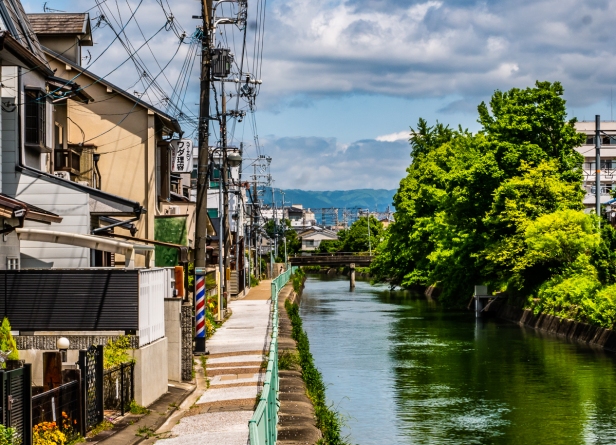
Spontaneously I walk towards it. I’m about due to have my hair buzzed off and here’s my answer. It turns out to be the most elaborate, and expensive, head-buzzing ever.
I walk in and discover a small establishment with two men, and two chairs, both vacant. I mime that I want my hair buzzed off and am invited to one of the chairs. I am royally fussed over. A small towel is tucked into the neck of my t-shirt, a paper is wrapped around my neck, then the usual salon cape is draped around me with not one but both men spreading it out. A hot towel is wrapped around my head (sigh) and a hot collar draped around my neck and shoulders. I close my eyes as I sink ever deeper into the chair. Powder is dusted on my head, followed by a slow careful buzzing. Then I’m asked if I want a shave! I hope he’s referring to my head and not my face! I decline.
The barber picks up a square item made of hard rubber that fits in the palm of his hand. It has widely spaced “teeth”. He uses it to massage my head, then brushes my head with a smaller brush, and then again with a softer brush. A little powder is sprinkled on my neck. Collar, cape, paper and towel are removed and I’m brushed off with a little broom. It is done.
When Don and I buzz each other’s heads it takes about five minutes and then we shower off all the debris.
The most we’ve ever paid to have it done by a barber is $24 in Vancouver. The least is $1.50 in India. The elaborate ritual I undergo in Japan costs $36. It’s worth it just for the experience.
Shimogyo Ward, where my hostel is located, is mostly modern with more traditional buildings, such as these ones, scattered here and there,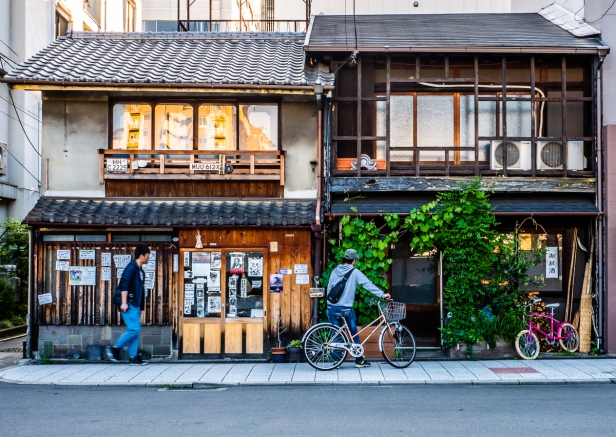
but “Old Kyoto”, the Kyoto of earlier eras, is to be found in Gion and Higashiyama.
I wander around the Gion area one evening stalking geiko. Geiko is the word for geisha in the Kyoto dialect. I’m in the right location. This is where the Geiko houses are. And I’m there at roughly the right time to maybe catch one or two as they head out to their evening engagements, but alas no, it is not my destiny to see any. I am however charmed by the centuries-old buildings.
It is here, in the ochaya, or teahouses, that the patrons of Gion have been entertained by geiko in private exclusive ceremonies for centuries. This practice has continued without interruption from the samurai of ancient times to modern day businessmen.
To be clear geisha, geiko, and maiko (apprentice geiko) are not, and never have been prostitutes; rather they are artists, entertaining with music, singing, dancing, conversation, and games. It is an exclusive, elegant, private world. I have no entree into this world, but can only wistfully hope to catch a glimpse of it. I’m attracted by the ritual and the elegance and most of all by the mystery. I have, however, to content myself with the traditional buildings, quietly but resolutely guarding their secrets.

On the lower slopes of Kyoto’s eastern mountains is Higashiyama where the two-kilometre stretch between Kiyomizudera Temple and Yasaka Shrine is one of the best-preserved historic areas. Up near the temple it’s crowded with foreign and domestic tourists, and school children on a cultural excursion,
but lower down where the streets are lined with traditional town houses known as machiya it’s quieter. I’m charmed by the weathered wood, the tiled roofs; the look and feel of a kind of ageless stability. I’m curious by nature. These machiya have the feeling that much more goes on there than I can see. I want to know what’s inside, how the families live, if there is the same timeless grounded feel inside as there is on the outside. The buildings seem to radiate both a quiet sense of privacy and at the same time a feeling of welcome.

As I make my way up to the higher levels of the area, towards the Kiyomizudera Temple,
the streets become narrower and open only to pedestrians. Near the temple I find a bench in the shade and savour soft ice cream, and later find a place for coffee. It is not Starbucks. Not here. Here, lining the narrow alleys there are cafes and restaurants
and merchant stores that have been in the same families for generations. They sell exquisite Kiyomizu-yaki pottery,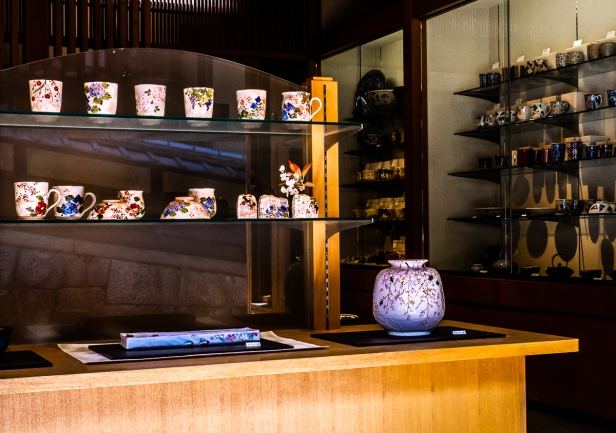
fans,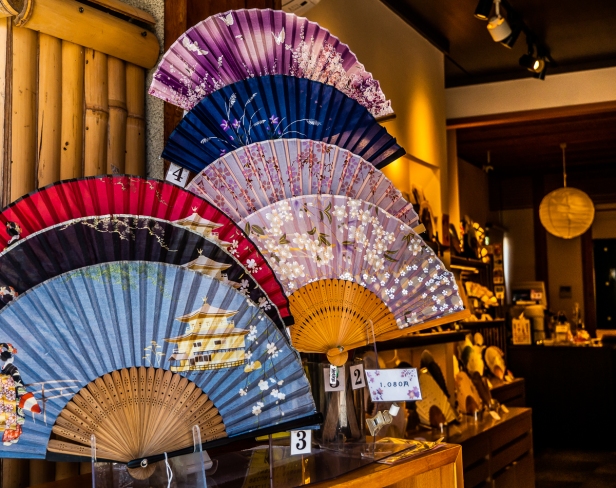
masks and tourist trinkets,
sweets, traditional Japanese dolls, oiled-paper umbrellas, and things I cannot fathom.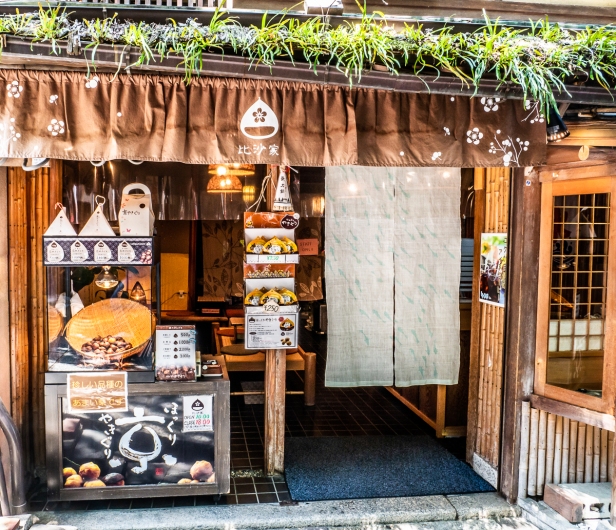

Higashiyama, perhaps more than any other part of Kyoto, invokes the feeling of life in earlier times when the city was the capital of Japan. The businesses and buildings have preserved their traditional design, and the feeling is further enhanced since power poles and lines have been removed from sight on the main streets.
I walk and walk, following the cobbled streets towards Yasaka Shrine. I stop in one of the restaurants for a lunch of rice with vegetable and prawn tempura that nourishes both body and soul, and then walk some more, traversing the cobbled streets, peering down tiny side alleyways lined with machiya,
alongside gardens, and at times high up overlooking the town and the towering Yasaka Pagoda.
I’m making my way to the Philosopher’s Path. I’d read that “good walkers” could walk from Yasaka Shrine all the way north to the Philosopher’s Path and the Ginkaku-Ji Temple. Considering myself a “good walker” I continue on. I haven’t really investigated how long this will take; I simply follow the arrow on my phone.
I walk through the lovely gardens of Maruyama Park near Yasaka Temple,
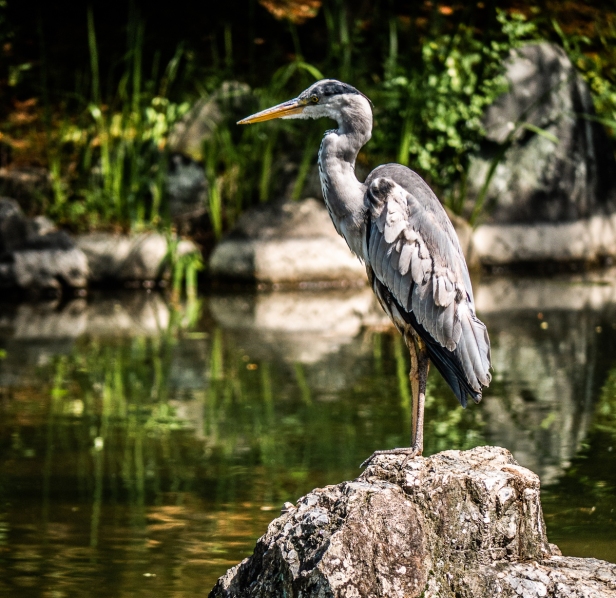
and I pass by several of Kyoto’s 2000 temples and shrines. The city is Japan’s spiritual capital.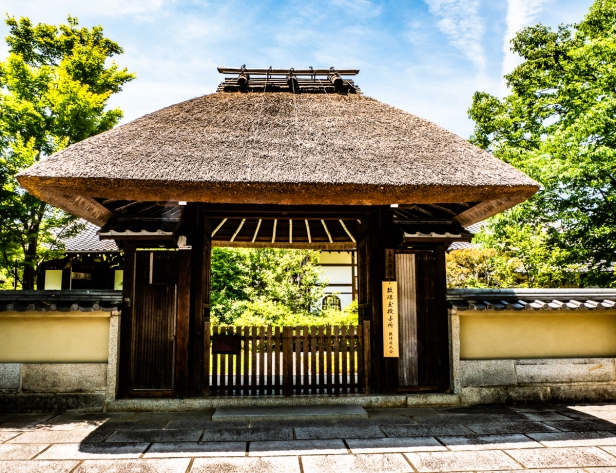
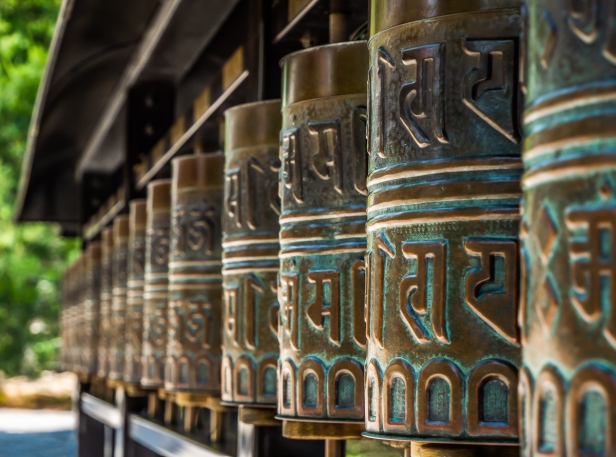

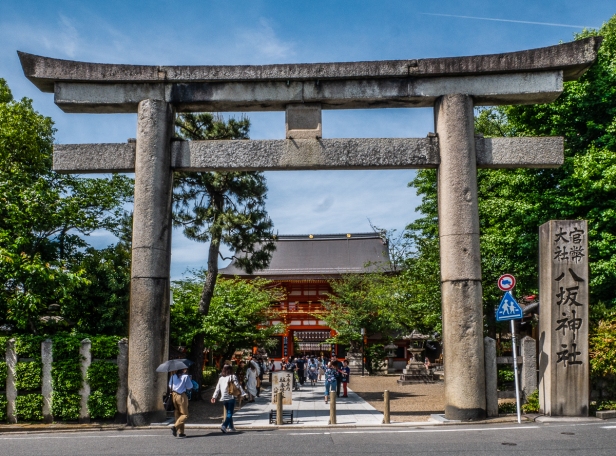

but for quite a time I’m on fairly main roads that are all modern industrialised Japan. I could be anywhere. It’s perishing hot. I have no water with me. I had no idea the walk would be this long or this uninteresting. After about forty minutes I head onto smaller streets.
And then I see a rectangular metal structure that I think will save my life. I bow to the god of vending machines, and, inserting the correct coins, I extract a small can of ice-cold latte. I drain it in almost one gulp. Of course I knew about Japan’s love of vending machines but had not used one until now. Suddenly I understand. I have been converted. I am a believer!
There are 5.5 million vending machines in Japan and annual sales total more than sixty billion yen. Soft drinks, coffee, tea, cigarettes, candy, soup, hot food, sake, beer, rice, umbrellas, batteries, bagged vegetables, fortunes, t-shirts, electronics, ice cream, condoms, flowers, ties, toys, surgical masks, ramen, bananas, eggs, porn, pantyhose, puppies! Oh I have to stop. This is by no means a complete list. Drinks and meals that should be hot will be hot; things that should be cold will be cold or ice cold as appropriate. On this day, after walking for nearly an hour in relentless heat, I fall in love with them.
Walking on I find another vending machine and have a second latte, and soon after I finally arrive at the beginning of the Philosopher’s Path. It is a little slice of heaven. No longer is there noise and traffic. I’m walking on a narrow path by a small canal. The path is shaded by the surrounding lush greenery. Trees and moss, and the rippling of water now accompany me instead of bare concrete sidewalks and traffic.
It’s a quiet green oasis high above the city and I feel my shoulders relax. I slow down. I breathe in the green beauty all around me.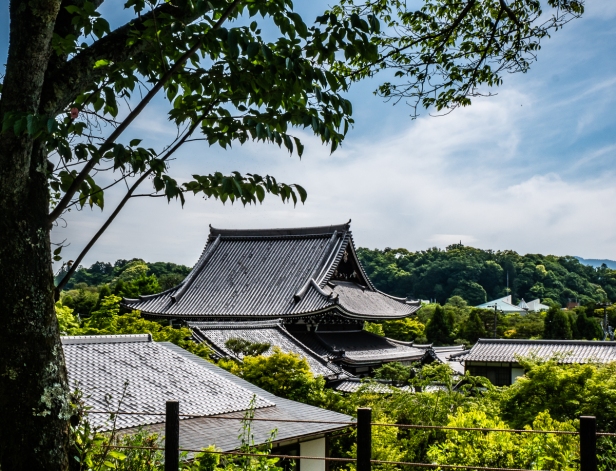
The Philosopher’s Path is approximately two kilometres long, and is named for the famous Japanese philosopher Nishida Kitaro. Nishida graduated from Kyoto University with a degree in philosophy in 1894, and eventually became a prominent professor. It is said that he would meditate while walking along the path on his daily commute to the university.

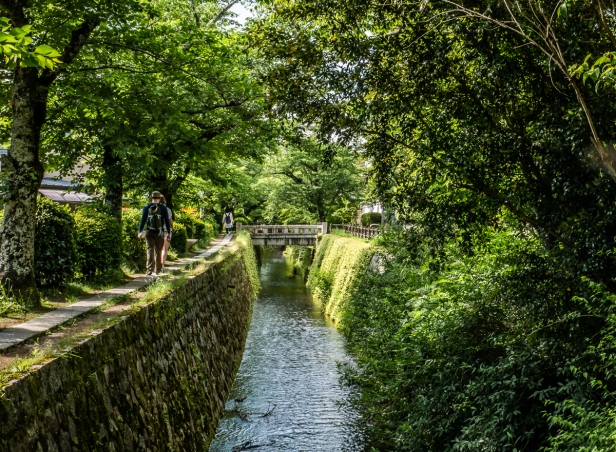
At the end of the path I turn onto the street leading to Ginkaku-ji Temple. As with all important temples the world over the street leading to it is lined with shops and cafes for all the devotees and tourists. I walk on by and start the climb up to the temple. Suddenly I stop. I am done. I simply don’t have the energy to walk any more, let alone up hill. I make my way back down to the street and enjoy my second soft ice cream of the day. I need this so much more than I need to see another temple.
As I’m walking along the Philosopher’s Path and starting to tire the thought keeps arising how will I ever find my way home? And every time the immediate answer is trust the unfolding. While eating my ice cream I pull out my old-fashioned paper map of Kyoto and see there’s Keihan Line information on the back of it. My hostel is two minutes walk from the Keihan line. The map also shows the name of the station nearest to Ginkaku-ji Temple. I walk down the road a bit and see a taxi stand. I get a taxi to the station and a train home. Simple.
While in Japan I did a lot of walking, much of it unnecessary, and some of it really pushing myself. I seemed to unconsciously create more walking than I needed to do by going in the wrong direction, or not correctly following directions, or not reading the map accurately, or being given the wrong directions, or not learning how to use maps.me properly. I felt, and often was, incompetent, and many days I walked more than necessary because of it, but I also think at some level I was testing myself. I was unconsciously pushing myself, wanting to find out just how much I could do, because I had the tour in China coming up, and when you’re on a tour there’s only limited possibility to go at your own pace. On a tour you have to be able to keep up. So for all I walked more than I needed to, and for all I pushed myself, sometimes beyond stupid, Japan turned out to be getting fit for China in a way that I hadn’t been able to do before I left Canada. It worked. And by the end of four weeks in China I was as fit as I’ve ever been.
Next post: Aoi Matsuri – a centuries old festival in Kyoto, and a geisha show.
A lovely article about Kyoto: In Kyoto, Feeling Forever Foreign
All words and images by Alison Louise Armstrong unless otherwise noted.
© Alison Louise Armstrong and Adventures in Wonderland – a pilgrimage of the heart, 2010-2018.

You stun Alison.
LikeLiked by 1 person
A humble and appreciative thank you Cindy. xo
LikeLike
What a post, Alison. So well written and chock full of interesting observations. Your haircut story rather epitomizes the dedication and attention to detail of the Japanese! Great photos…some of places I walked just a few weeks ago.
LikeLiked by 1 person
Thanks so much Jane. I do wish I’d had more time in Kyoto to really drink it in. There’s so much to see there. Yes, the haircut was so typically Japanese. I thought I’d be in and out in about 15 minutes at most, but it was over half an hour, and so painstaking.
Alison
LikeLiked by 2 people
Great report and excellent pictures.
LikeLiked by 1 person
Thanks so much rabirius.
Alison
LikeLike
Loved sharing some of your Kyoto walks. Beautiful. $36 for a buzz! Wow! Did sound good though.
LikeLiked by 1 person
Thanks Tracey. I wish I’d had more time there – it felt a bit rushed. The head buzzing was lovely.
Alison
LikeLike
We felt exactly the same, but we were only there for 3 days. Definitely going back at some point.
LikeLiked by 1 person
Just loved this post 🙂
Your narration is so captivating and the images are so beautiful 🙂
Feels like taking a walk through the narrow path ways and exploring the old part of the city…
Thank you so much for sharing 🙂
LikeLiked by 1 person
Thanks so much Sreejith. I’m glad you like my story-telling. Sometimes I’m not sure about it, but in the end I just write about how it was for me. And I realize I never take photos of the “uninteresting” things – like the long walk on more ordinary streets. Maybe that would have been a good illustration but I’m always drawn to beauty, and the old more authentic places. I’m glad you enjoyed following along.
Alison
LikeLiked by 1 person
Your story and photos really make me want to go back to Kyoto. I loved the old and modern fusion in the city, and the food, the numerous historical sights, and the convenience stores where I bought a restaurant-quality uni (sea urchin) spaghetti. I think it was also in Kyoto where I had my first ever hot drink from a vending machine. Your experience at the barbershop reminds me of what I got in Goa. It was the most elaborate haircut session I’ve ever had, not because of the hair style itself but more on the things the hairdresser used: from a vibrator to give me a massage on my back and neck to this mysterious oil.
LikeLiked by 1 person
Thanks Bama. I’m glad I brought back some good memories. I too would love to go back to Kyoto, and Japan generally. I loved it there. And I’d like the chance to explore the food more. Every time I was brave enough to walk into a restaurant and just order something it was the best meal ever! Though I too got some pretty good things at convenience stores.
That neck/back massage in Goa sounds wonderful.
Alison
LikeLiked by 1 person
What an absolutely gorgeous city Alison! I love how you got your hair buzzed too there. Those are some of the best cultural experiences of all times! I haven’t done a hair cut before but perhaps I should!
LikeLiked by 1 person
Oh it is a gorgeous city. I’d love to go back and have more time there.
I initially decided to get all my hair buzzed off because I was in India and didn’t think I could find a hairdresser I could trust to do a decent job. It was incredibly freeing. Not suggesting buzzing for you, but do try a haircut!
Alison
LikeLiked by 1 person
One, the buzz cut was fun, Alison. Sounds like it was worth $36 to me! I’m used to Peggy’s $50 bills. And walking. You know I am a fan. But getting lost in a strange city where you don’t know the language can be a bit of a bother. Sorry you missed the Geishas. 🙂 –Curt
LikeLiked by 1 person
The buzz cut was fun, and worth it, and very unexpected! And the complete opposite of India where the barber brushed my face (!) with the same small broom that had also been used (since Adam was a boy) to sweep the floor. Ewwwww.
I’d love to have seen a geisha or two! Maybe next time.
Getting around in Japan was often a challenge, and I really was incompetent at times, which is not a feeling I want to get used to, but it always seemed to work out and I’d find my way home. People are very helpful there.
Alison
LikeLike
No wonder you got fit Alison. It is always surprising how far you walk in a new place. So much to see, such interesting architecture, observing the culture and people watching. It just pulls you on and on and you have taken us with you showing the buildings and fascinating culture. I smiled all the way through your haircut experience.
LikeLiked by 1 person
I know exactly what you mean about walking in a new place – oh I’ll just look down here, and what’s around that corner? and look over there what’s that? and so it goes and I walk and walk and walk.
The hair cut was a pretty neat experience. So unexpected. I thought I’d be out of there in about 10 or at most 15 minutes. I think it all took about 35-40 mins.
Alison
LikeLiked by 1 person
A true traveller always wants to see what is over the hill and around the corner…
LikeLiked by 1 person
You are such a generous writer, taking us all on the journey with you. Beautiful.
LikeLiked by 1 person
Thanks, and as are you! I’ve been catching up with your blog. I’d lost track of you somehow. Anyway I’ve signed up again. I like the new layout. And you’re funny!
Glad you enjoyed this post.
Alison
LikeLike
That hair buzz sounds like an experience! It isn’t quite the same in Bangkok, but a haircut usually involves a head massage and wash. But the price is like $8.
I tend to walk more than needed too, especially when alone. I can’t make myself use taxis or public transport for some reason.
Great collection of photos. Not sure what it is about it, but the night photo about 5 shots down is great. The geometry, light and peaceful vibe are really nice.
LikeLiked by 1 person
I think the only way to really see a city (within reason of course) is to walk. I did use the trains, and once took a bus because things I wanted to see were too far away, but I do like walking best.
Head massage and cut for $8 – what a deal!
Thanks re the photos. I also like the one you mention, and I’m always pleased when a night shot turns out.
Alison
LikeLike
Wow Alison, to walk all the way from Higashiyama to Ginkaku-ji in the summer heat must have been a real workout. When Bama and I went two years ago we “cheated” by hitching a public bus; doing that gave us the time to wander the temple grounds (which has great views from up the hillside). We stayed in Higashiyama and it was great to go on early morning walks around Kiyomizu-dera while most other tourists were still in bed.
My very first brush with the Philosopher’s Path was 16 years ago on a family trip at the height of cherry blossom season. Imagine all the trees along the canal making a canopy of soft pinks and whites – that’s what it was like. I’d love to revisit the place at the same time of year, although I will have to brace for big crowds.
Amid the gorgeous street scenes and landscapes, one shot that stood out for me was the prayer wheels inscribed with Tibetan characters; I was definitely not expecting to see that at a traditional temple in Kyoto.
And only the Japanese could make the experience of a buzz-cut so sublime!
LikeLiked by 1 person
I was so not prepared for that walk. I should have researched it more (ie checked the distance and time on google maps) but I just trusted the article I’d read. Silly me. Still it certainly helped with improving fitness and stamina.
It must have been lovely to get to Kiyomizudera early before the crowds arrived. That was another temple where I went up to the gates but didn’t go inside.
I’ve seen pictures of the Philosopher’s Path during cherry blossom season – glorious!
I have no idea where those prayer wheels are but guessing somewhere around the Yasaka Shrine area (yet another shrine/temple I walked on by). I guess I only really visited a very select few temples and shrines lol 🙂
And yes the buzz cut was lovely.
Alison
LikeLiked by 1 person
This really brought some memories back! I first went through the Philosopher’s Path in 2009, my first intercontinental, and then again in 2016. Kyoto, I realised both time, wouldn’t be a bad place to live in for a while. Thanks for the tour!
LikeLiked by 1 person
I really liked Kyoto, and would love to go back. My time there felt so rushed. I’d like to have days there and get to some of the shrines and temples very early and just sit. And time to go to the river and sit on the banks and people watch. I can see why you’d think it a good place to live for a while.
The philosopher’s path was such a welcome relief – I’m glad I went there even if it did involve that long hot hike.
Alison
LikeLiked by 1 person
Thank you so much for taking me back to Kyoto, I place that I visited many, many, many years ago (1982) and sadly, without a camera. The images had disappeared from my mind and only the feelings of love (and remembrances of all the vending throughout the streets of Japan) remained in my memory. Your photos and words have made Kyoto come vividly alive for me again and have deepened longing to return.
Am delighted that the streets of Kyoto aided your recovery offering the opportunity for many meandering walks. And I adored sharing a few minutes with you in that barber’s chair.
LikeLiked by 1 person
Thank you so much Lisa, and you’re welcome! Kyoto’s a really special place I think. I hope you get back there one day. I’d like to go back too, and to Japan generally. I loved it there. So much world so little time. Sigh.
The barber experience was lovely. Sigh again.
Alison
LikeLike
I love your wanderings and reflections Alison! The fact that you walked into that barber shop to get your hair buzzed is so cool. I’m glad it was worth the money. What a fun fact about the vending machines…I had no idea! Your photos are all lovely but there’s something about the cobbled street with the parked bike that particularly strikes me (maybe the vertical lines?)
LikeLiked by 1 person
Thanks Caroline. The hair buzzing was definitely worth it, and so unexpected.
I was blown away by the vending machines. In the major metro stations there are great banks of them and of course I had no idea what anything was. It was too intimidating to even try to choose anything, but I’m so glad on my long walk that I recognized coffee!
I too like the one with the bike – such a tiny side street both mysterious and welcoming.
Alison
LikeLiked by 1 person
It is my life’s dream to go there. Thank you for sharing so beautifully. 🙂 🙂
LikeLiked by 1 person
Thank you, and you’re welcome Jo. I hope you get there one day. Japan is magical. I’d love to go back and explore more.
Alison
LikeLiked by 1 person
Your buzz sounds amazing – what a story – leave it to the Japanese, and to your sense of adventure. I’m glad you followed your instincts and checked out the barber pole. Those machiya do have something special – simplicity without coldness, and respect for tradition without going overboard. The narrow, steep streets are beautiful too, and all the shops are so much prettier than the crowded, plastic displays i associate with Japanese retail. 🙂 But then, Kyoto is a whole ‘nother thing, isn’t it?
I love the prayer wheel shot, and the Philosopher’s Path images. No wonder your shoulders dropped. Once again, you’ve brought a very personal point of view to life, making your trip so believable and vivid.
LikeLiked by 1 person
Thanks Lynn. I have no idea where the prayer wheel shot was taken – one of the temples I passed on my walk, and the Philosopher’s Path was sheer delight, and much needed by the time I reached it. It is lined with cherry trees. I can only imagine how gorgeous it is in the spring when the blossoms are out.
I knew I was due to have my hair buzzed off, and also that if I don’t do it fairly regularly it gets to look really messy. I hadn’t been looking but when I saw the barber pole there was no hesitation – turned out to be just what I needed, and a good story!
Kyoto *is* a whole ‘nother thing, in that there are well preserved historic places, and a love of tradition, but for sure I found some sweet neighbourhoods in Tokyo, and rural Japan still has some traditional housing and ways. I wished I’d had more time there.
Alison
LikeLike
Isn’t that always the way – wishing one had more time in a place? The wonderful thing is, it kind of continues on here, right? 😉
LikeLiked by 1 person
This must be my favorite of your Japan posts. For a number of years before I met my husband, I dated a serious Japanophile, and he introduced me to so much literature and history – much of it centered on Kyoto and the days of imperial Japan. Reading your words and seeing the photos took me right back to all that reading. Books have always been my nudge to visit certain places, and I must have shoved all this reading back in my mind (probably to suppress the old boyfriend somehow! 🙂 ) to the point where Japan never quite bubbled up to the top of my list. To be fair, it has moved up there for a few years now, but your posts are slowly re-igniting the part of my head that housed all this fascinating history and culture. If my Bhutan trip in April falls apart (sadly, it may), I think I may pounce on Japan, finally!
On a lighter note, I adored the hair-buzzing story! It just sounds like a real treat in every way.
LikeLiked by 1 person
I took a long time to get going on this post. I thought it wouldn’t be interesting enough. And it’s your favourite! Thank you!
Japan is so worth visiting, and Kyoto is quite special. It’s one of my favourite countries and I’d love to go back. I hope you get there (but not necessarily at the expense of your Bhutan trip).
The hair buzzing was so typical of Japan. Everything is done with such care and precision.
Alison
LikeLiked by 1 person
I like this travel story.This place temple was look wonderful .This place foods is interesting .
LikeLiked by 1 person
Thank you Subrata. I agree the temples are wonderful, and the food is *delicious*!
Alison
LikeLiked by 1 person
Right
LikeLiked by 1 person
Your opening drew me in immediately, Alison, and the photos and narrative from there were beautiful. I really enjoyed this. I’ve never been to Japan, but it has always been a place that intrigued me. I’m grateful for the virtual tour, and you’ve probably left by now, but I would have loved to hear a first hand account of Christopher Alexander’s Eishin School in Tokyo. I read his book this year entitled The Battle for the Life and Beauty of the Earth and really enjoyed it. That book is a history of his struggles to build something beautiful, in competition with a modern profit-centered mindset and modern construction techniques. Anyway, thoroughly enjoyed this… as always!
Peace
Michael
LikeLiked by 1 person
Thank you so much Michael. I’m glad you enjoyed wandering around Kyoto with me. It’s a beautiful city. Japan is beautiful. I fell in love with Japan and I’d love to go back.
I’m no longer there. From Japan I went to China for 4 weeks and arrived back in Vancouver in June – so a while ago.
I had to google Christopher Alexander and the Eishin school. The school building looks interesting, and maybe I’d have visited if I’d known about it. I did search out some other quite spectacular buildings in Tokyo.
Peace always
Alison
LikeLike
Nice blog
LikeLiked by 1 person
Thank you!
Alison
LikeLike
Kyoto is one of our favourite cities in Japan. We travel there almost every year.
LikeLiked by 1 person
I really enjoyed Kyoto. I wish I’d had more time there. There’s so much to explore there, and so much that I didn’t get to.
Alison
LikeLiked by 1 person
Same for us. We go back all the time yet we find new things!
LikeLiked by 1 person
wonderfully I’m brought
into ancient Japan
freshly with the light
of your images & words
of today 🙂
LikeLiked by 1 person
Thank you for your
lovely words.
Happy you enjoyed ancient Japan with me.
Alison
LikeLike
You have opened my eyes to Japan in a way I had not expected Alison. The beauty, the serenity, the spirituality, is all very alluring. And your photography is breathtaking.
LikeLiked by 1 person
Thanks so much LuAnn. Japan was an eye opener for me, and incredibly wonderful. I’m so glad I went and would love to go back.
Alison
LikeLiked by 1 person
I’m new to your blog and I’ve enjoyed delving into your archives. This post brought back some wonderful memories of a solo trip I did to Japan that included Kyoto. Like, you I didn’t see any Geishas but I walked a lot…. and I saw a lot of temples… but each one was so different from the other I never felt bored.
My favourite part of this post was, however, reading about your trip to the hairdressers. It struck me as a very personal and non-touristy thing to do. Hah.
LikeLiked by 1 person
Thank you so much Shing. Glad I brought back some good memories for you, though with Kyoto I would think it would be the same for anyone who’s been there. Such a lovely city! There is a post somewhere on the blog about having my hair buzzed in various countries – India, Cambodia, Peru, etc. We lived on the road for nearly 6 years so got used to trying out local things like that. I must say that the Japan experience was the most pampering I’ve ever had.
Alison
LikeLike
Have you saved your heart? Or just it lost in the imperial heart?
Because I can’t save it if Will do that
LikeLiked by 1 person
I have lost my heart and saved it both. I save it by losing it – to love, to cities like Kyoto, to people, to life.
Thank you for all the “likes”
Alison
LikeLike
Love.
Beautiful answer as expected from beautiful person.
LikeLiked by 1 person
Great excursion. Thank you. Your photographs are amazing.
LikeLiked by 1 person
Thank you so much Victor. Kyoto is such a lovely city. We’re going back in March for anther visit.
Alison
LikeLiked by 1 person
Oh! Lucky you.
LikeLiked by 1 person